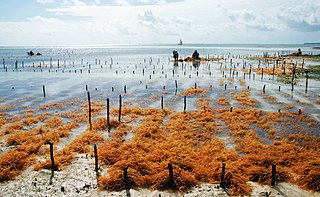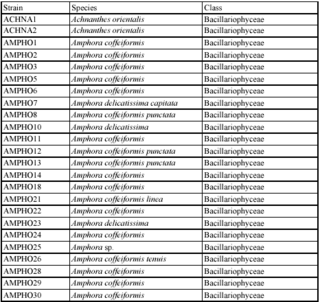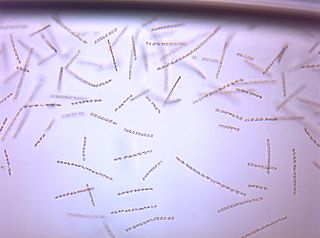
Microalgae or microphytes are microscopic algae invisible to the naked eye. They are phytoplankton typically found in freshwater and marine systems, living in both the water column and sediment. They are unicellular species which exist individually, or in chains or groups. Depending on the species, their sizes can range from a few micrometers (μm) to a few hundred micrometers. Unlike higher plants, microalgae do not have roots, stems, or leaves. They are specially adapted to an environment dominated by viscous forces.

Algaculture is a form of aquaculture involving the farming of species of algae.

The SERI microalgae culture collection was a collection from the Department of Energy's Aquatic Species Program cataloged at the Solar Energy Research Institute located in Golden, Colorado. The Aquatic Species Program ended in 1996 after its funding was cut, at which point its microalgae collection was moved to the University of Hawaii. In 1998 the University of Hawaii, partnered with the University of California at Berkeley, received a grant from the National Science Foundation (NSF), for their proposal to develop commercial, medical, and industrial uses of microalgae, as well as new and more efficient techniques for cultivation. This grant was used to form Marine Bioproduct Engineering Center (MarBEC), a facility operating within the University system of Hawaii at Manoa, but connected to corporate interests.

Acoela, or the acoels, is an order of small and simple invertebrates in the subphylum Acoelomorpha of phylum Xenacoelomorpha, a deep branching bilaterian group of animals, which resemble flatworms. Historically they were treated as an order of turbellarian flatworms.

Integrated multi-trophic aquaculture (IMTA) provides the byproducts, including waste, from one aquatic species as inputs for another. Farmers combine fed aquaculture with inorganic extractive and organic extractive aquaculture to create balanced systems for environment remediation (biomitigation), economic stability and social acceptability.

Algae fuel, algal biofuel, or algal oil is an alternative to liquid fossil fuels that uses algae as its source of energy-rich oils. Also, algae fuels are an alternative to commonly known biofuel sources, such as corn and sugarcane. When made from seaweed (macroalgae) it can be known as seaweed fuel or seaweed oil.

Chaetoceros is a genus of diatoms in the family Chaetocerotaceae, first described by the German naturalist C. G. Ehrenberg in 1844. Species of this genus are mostly found in marine habitats, but a few species exist in freshwater. It is arguably the common and most diverse genus of marine planktonic diatoms, with over 200 accepted species. It is the type genus of its family.

Bacteriastrum is a genus of diatoms in family Chaetocerotaceae. There are more than 30 described species in genus Bacteriastrum, but many of these are not currently accepted, and new species are still added to the genus. The type species for the genus is Bacteriastrum furcatum Shadbolt.

Turritriton is a genus of medium-sized sea snails, marine gastropod molluscs in the family Cymatiidae. This is often still regarded merely as a subgenus of the genus Cymatium.
Nasrin Moazami is an Iranian medical microbiologist and biotechnologist. She received her Ph.D. in 1976 from the Faculty of Medicine at Laval University. Moazami is the pioneer of biotechnology and microalgae-based fuels in Iran.

Microalgae or microscopic algae grow in either marine or freshwater systems. They are primary producers in the oceans that convert water and carbon dioxide to biomass and oxygen in the presence of sunlight.
Thalassiosira weissflogii is a species of centric diatoms, a unicellular microalga. It is found in marine environments and also in inland waters in many parts of the world. It is actively studied because it may use C4-plant style strategies to increase its photosynthetic efficiency.
The Spanish Bank of Algae is a national R&D service attached to the Marine Biotechnology Center of the University of Las Palmas de Gran Canaria (ULPGC), which objectives are the isolation, identification, characterization, conservation and provisioning of microalgae and cyanobacteria. It was previously known as the National Bank of Algae (BNA).

Tracheloraphis is a genus of ciliates in the family Trachelocercidae.

Thalassiosira is a genus of centric diatoms, comprising over 100 marine and freshwater species. It is a diverse group of photosynthetic eukaryotes that make up a vital part of marine and freshwater ecosystems, in which they are key primary producers and essential for carbon cycling

Bacilladnaviridae is a family of single-stranded DNA viruses that primarily infect diatoms.
Chaetoceros coarctatus is a marine, unicellular species of planktonic diatom in the genus Chaetoceros, first described by Lauder in January 1864 using samples from the Hong Kong harbor. Like many diatoms, it is preyed upon by ctenophores. During warming periods of the Mediterranean Sea, this non-native species, first introduced through the Suez Canal, expands its range. Cell chains showcase pairs of posterior and anterior terminal setae, as well as intercalary setae, for anti-predatory mechanical protection and floating benefits. These silica appendages have spines, curved tips, and are longer those on other members of the Chaetoceros genus for higher survival benefits.
Odontella sinensis, also known as the Chinese diatom, is a marine, unicellular species of diatom in the family Triceratiaceae.

Leptocylindrus is a genus of diatoms belonging to the family Leptocylindraceae. They are long, cylindrical diatoms that are made up of multiple cells in a line. These cells have chloroplast to allow it to produce energy through photosynthesis by taking in sunlight and carbon dioxide to create sugars. the cells are attached at the cell walls called valves, the cell wall is slightly concave on one side and convex on the other so that the other cell wall attached will fit together.
Algal viruses are the viruses infecting algae, which are photosynthetic single-celled eukaryotes. As of 2020, there were 61 viruses known to infect algae. Algae are integral components of aquatic food webs and drive nutrient cycling, so the viruses infecting algal populations also impacts the organisms and nutrient cycling systems that depend on them. Thus, these viruses can have significant, worldwide economic and ecological effects. Their genomes varied between 4.4 to 560 kilobase pairs (kbp) long and used double-stranded Deoxyribonucleic Acid (dsDNA), double-stranded Ribonucleic Acid (dsRNA), single-stranded Deoxyribonucleic Acid (ssDNA), and single-stranded Ribonucleic Acid (ssRNA). The viruses ranged between 20 and 210 nm in diameter. Since the discovery of the first algae-infecting virus in 1979, several different techniques have been used to find new viruses infecting algae and it seems that there are many algae-infecting viruses left to be discovered













